Contrasting the Effects of X-Band Phased Array Radar and S-Band Doppler Radar Data Assimilation on Rainstorm Forecasting in the Pearl River Delta
Abstract
:1. Introduction
2. Data and Methods
2.1. Observation Data
2.2. DA Method
2.2.1. 3Dvar
2.2.2. Radar Observation Operator
3. Case Introduction and Experimental Design
3.1. Overview of the Case
3.2. Model and Experimental Design
4. Data Analysis and Experimental Results
4.1. Radar Data Comparison Analysis
4.2. The Analysis Increment in the First Assimilation Cycle
4.3. Analysis Results
4.3.1. Wind Analysis
4.3.2. Radar Echo Analysis
4.3.3. Hydrometeor Analysis
4.4. Forecasting Results
4.4.1. Composite Reflectivity Forecast
4.4.2. Vertical Structure Analysis
4.4.3. Precipitation Forecast
5. Summary
Author Contributions
Funding
Data Availability Statement
Acknowledgments
Conflicts of Interest
References
- Zhang, A.; Xiao, L.; Min, C.; Chen, S.; Kulie, M.; Huang, C.; Liang, Z. Evaluation of Latest GPM-Era High-Resolution Satellite Precipitation Products during the May 2017 Guangdong Extreme Rainfall Event. Atmos. Res. 2019, 216, 76–85. [Google Scholar] [CrossRef]
- Aksoy, A.; Dowell, D.C.; Snyder, C. A Multicase Comparative Assessment of the Ensemble Kalman Filter for Assimilation of Radar Observations. Part I: Storm-Scale Analyses. Mon. Weather. Rev. 2009, 137, 1805–1824. [Google Scholar] [CrossRef]
- Shen, F.; Xu, D.; Min, J.; Chu, Z.; Li, X. Assimilation of Radar Radial Velocity Data with the WRF Hybrid 4DEnVar System for the Prediction of Hurricane Ike (2008). Atmos. Res. 2020, 234, 104771. [Google Scholar] [CrossRef]
- Fabry, F.; Meunier, V. Why Are Radar Data so Difficult to Assimilate Skillfully? Mon. Weather. Rev. 2020, 148, 2819–2836. [Google Scholar] [CrossRef]
- Shen, F.; Song, L.; He, Z.; Xu, D.; Chen, J.; Huang, L. Impacts of Adding Hydrometeor Control Variables on the Radar Reflectivity Data Assimilation for the 6–8 August 2018 Mesoscale Convective System Case. Atmos. Res. 2023, 295, 107012. [Google Scholar] [CrossRef]
- Zheng, H.; Chen, Y.; Zheng, S.; Meng, D.; Sun, T. Radar Reflectivity Assimilation Based on Hydrometeor Control Variables and Its Impact on Short-Term Precipitation Forecasting. Remote Sens. 2023, 15, 672. [Google Scholar] [CrossRef]
- Wang, C.; Chen, M.; Chen, Y. Impact of Combined Assimilation of Wind Profiler and Doppler Radar Data on a Convective-Scale Cycling Forecasting System. Mon. Weather Rev. 2022, 150, 431–450. [Google Scholar] [CrossRef]
- Xu, D.; Yang, G.; Wu, Z.; Shen, F.; Li, H.; Zhai, D. Evaluate Radar Data Assimilation in Two Momentum Control Variables and the Effect on the Forecast of Southwest China Vortex Precipitation. Remote Sens. 2022, 14, 3460. [Google Scholar] [CrossRef]
- Shen, F.; Xu, D.; Min, J. Effect of Momentum Control Variables on Assimilating Radar Observations for the Analysis and Forecast for Typhoon Chanthu (2010). Atmos. Res. 2019, 230, 104622. [Google Scholar] [CrossRef]
- Shen, F.; Shu, A.; Liu, Z.; Li, H.; Jiang, L.; Zhang, T.; Xu, D. Assimilating FY-4A AGRI Radiances with a Channel-Sensitive Cloud Detection Scheme for the Analysis and Forecasting of Multiple Typhoons. Adv. Atmos. Sci. 2024, 41, 937–958. [Google Scholar] [CrossRef]
- Xu, D.; Shen, F.; Min, J. Effect of Background Error Tuning on Assimilating Radar Radial Velocity Observations for the Forecast of Hurricane Tracks and Intensities. Meteorol. Appl. 2020, 27, e1820. [Google Scholar] [CrossRef]
- Zhang, G.; Mahale, V.N.; Putnam, B.J.; Qi, Y.; Cao, Q.; Byrd, A.D.; Bukovcic, P.; Zrnic, D.S.; Gao, J.; Xue, M.; et al. Current Status and Future Challenges of Weather Radar Polarimetry: Bridging the Gap between Radar Meteorology/Hydrology/Engineering and Numerical Weather Prediction. Adv. Atmos. Sci. 2019, 36, 571–588. [Google Scholar] [CrossRef]
- Zrnic, D.S.; Kimpel, J.F.; Forsyth, D.E.; Shapiro, A.; Crain, G.; Ferek, R.; Heimmer, J.; Benner, W.; McNellis, F.T.J.; Vogt, R.J. Agile-Beam Phased Array Radar for Weather Observations. Bull. Am. Meteorol. Soc. 2007, 88, 1753–1766. [Google Scholar] [CrossRef]
- Stratman, D.R.; Yussouf, N.; Jung, Y.; Supinie, T.A.; Xue, M.; Skinner, P.S.; Putnam, B.J. Optimal Temporal Frequency of NSSL Phased Array Radar Observations for an Experimental Warn-on-Forecast System. Weather. Forecast. 2020, 35, 193–214. [Google Scholar] [CrossRef]
- Chandrasekar, V.; Mclaughlin, D.; Zink, M. The CASA IP1 Test-Bed after 5 Years Operation: Accomplishments, Breakthroughs, Challenges and Lessons. In Proceedings of the 6th European Conference on Radar in Meteorology and Hydrology: Advances in Radar Technology, Sibiu, Romania, 6–10 September 2010; ERAD: Sibiu, Romania, 2010. [Google Scholar]
- Zhang, X.; Huang, X.; Liu, X.A.; Lu, J.; Geng, L.; Huang, H.; Zhen, G. The Hazardous Convective Storm Monitoring of Phased-Array Antenna Radar at Daxing International Airport of Beijing. J. Appl. Meteorol. Sci. 2022, 33, 192–204. [Google Scholar]
- Lin, X.; Feng, Y.; Xu, D.; Jian, Y.; Huang, F.; Huang, J. Improving the Nowcasting of Strong Convection by Assimilating Both Wind and Reflectivity Observations of Phased Array Radar: A Case Study. J. Meteorol. Res. 2022, 36, 61–78. [Google Scholar] [CrossRef]
- Huang, Y.; Wang, X.; Kerr, C.; Mahre, A.; Yu, T.-Y.; Bodine, D. Impact of Assimilating Future Clear-Air Radial Velocity Observations from Phased-Array Radar on a Supercell Thunderstorm Forecast: An Observing System Simulation Experiment Study. Mon. Weather Rev. 2020, 148, 3825–3845. [Google Scholar] [CrossRef]
- Yussouf, N.; Stensrud, D.J. Impact of Phased-Array Radar Observations over a Short Assimilation Period: Observing System Simulation Experiments Using an Ensemble Kalman Filter. Mon. Wea. Rev. 2010, 138, 517–538. [Google Scholar] [CrossRef]
- Huang, Y.; Wang, X.; Mahre, A.; Yu, T.-Y.; Bodine, D. Impacts of Assimilating Future Clear-Air Radial Velocity Observations from Phased Array Radar on Convection Initiation Forecasts: An Observing System Simulation Experiment Study. Mon. Weather. Rev. 2022, 150, 1563–1583. [Google Scholar] [CrossRef]
- Ming, J.; Gong, P.; Lu, Y.; Zhao, K.; Huang, H.; Chen, X.; Wang, S.; Zhang, Q. Impact of Assimilating C-Band Phased-Array Radar Data With EnKF on the Forecast of Convection Initiation: A Case Study in Beijing, China. J. Geophys. Res. Atmos. 2023, 128, e2023JD038542. [Google Scholar] [CrossRef]
- Wang, C.; Zhao, K.; Zhu, K.; Huang, H.; Lu, Y.; Yang, Z.; Fu, P.; Zhang, Y.; Chen, B.; Hu, D. Assimilation of X-Band Phased-Array Radar Data With EnKF for the Analysis and Warning Forecast of a Tornadic Storm. J. Adv. Model. Earth Syst. 2021, 13, e2020MS002441. [Google Scholar] [CrossRef]
- Helmus, J.J.; Collis, S.M. The Python ARM Radar Toolkit (Py-ART), a Library for Working with Weather Radar Data in the Python Programming Language. J. Open Res. Softw. 2016, 4, 25. [Google Scholar] [CrossRef]
- Wang, Y.; Wang, X. Development of Convective-Scale Static Background Error Covariance within GSI-Based Hybrid EnVar System for Direct Radar Reflectivity Data Assimilation. Mon. Weather. Rev. 2021, 149, 2713–2736. [Google Scholar] [CrossRef]
- Johnson, A.; Wang, X.; Carley, J.R.; Wicker, L.J.; Karstens, C. A Comparison of Multiscale GSI-Based EnKF and 3DVar Data Assimilation Using Radar and Conventional Observations for Midlatitude Convective-Scale Precipitation Forecasts. Mon. Weather. Rev. 2015, 143, 3087–3108. [Google Scholar] [CrossRef]
- Barker, D.M.; Huang, W.; Guo, Y.-R.; Bourgeois, A.J.; Xiao, Q.N. A Three-Dimensional Variational Data Assimilation System for MM5: Implementation and Initial Results. Mon. Weather. Rev. 2004, 132, 897–914. [Google Scholar] [CrossRef]
- Barker, D.; Huang, X.-Y.; Liu, Z.; Auligné, T.; Zhang, X.; Rugg, S.; Ajjaji, R.; Bourgeois, A.; Bray, J.; Chen, Y.; et al. The Weather Research and Forecasting Model’s Community Variational/Ensemble Data Assimilation System: WRFDA. Bull. Am. Meteorol. Soc. 2012, 93, 831–843. [Google Scholar] [CrossRef]
- Parrish, D.F.; Derber, J.C. The National Meteorological Center’s Spectral Statistical-Interpolation Analysis System. Mon. Weather. Rev. 1992, 120, 1747–1763. [Google Scholar] [CrossRef]
- Tong, M.; Xue, M. Ensemble Kalman Filter Assimilation of Doppler Radar Data with a Compressible Nonhydrostatic Model: OSS Experiments. Mon. Weather. Rev. 2005, 133, 1789–1807. [Google Scholar] [CrossRef]
- Wang, H.; Sun, J.; Fan, S.; Huang, X.-Y. Indirect Assimilation of Radar Reflectivity with WRF 3D-Var and Its Impact on Prediction of Four Summertime Convective Events. J. Appl. Meteorol. Climatol. 2013, 52, 889–902. [Google Scholar] [CrossRef]
- Shen, F.; Min, J.; Li, H.; Xu, D.; Shu, A.; Zhai, D.; Guo, Y.; Song, L. Applications of Radar Data Assimilation with Hydrometeor Control Variables within the WRFDA on the Prediction of Landfalling Hurricane IKE (2008). Atmosphere 2021, 12, 853. [Google Scholar] [CrossRef]
- Gao, J.; Stensrud, D.J. Assimilation of Reflectivity Data in a Convective-Scale, Cycled 3DVAR Framework with Hydrometeor Classification. J. Atmos. Sci. 2012, 69, 1054–1065. [Google Scholar] [CrossRef]
- Lin, Y.-L.; Farley, R.D.; Orville, H.D. Bulk Parameterization of the Snow Field in a Cloud Model. J. Clim. Appl. Meteorol. 1983, 22, 1065–1092. [Google Scholar] [CrossRef]
- Gilmore, M.S.; Straka, J.M.; Rasmussen, E.N. Precipitation and Evolution Sensitivity in Simulated Deep Convective Storms: Comparisons between Liquid-Only and Simple Ice and Liquid Phase Microphysics. Mon. Weather. Rev. 2004, 132, 1897–1916. [Google Scholar] [CrossRef]
- Dowell, D.C.; Wicker, L.J.; Snyder, C. Ensemble Kalman Filter Assimilation of Radar Observations of the 8 May 2003 Oklahoma City Supercell: Influences of Reflectivity Observations on Stormscale Analyses. Mon. Weather. Rev. 2011, 139, 272–294. [Google Scholar] [CrossRef]
- Skamarock, W.C.; Klemp, J.B. A Time-Split Nonhydrostatic Atmospheric Model for Weather Research and Forecasting Applications. J. Comput. Phys. 2008, 227, 3465–3485. [Google Scholar] [CrossRef]
- Hong, S.Y.; Lim, J.O.J. The WRF Single-Moment 6-Class Microphysics Scheme (WSM6). Asia Pac. J. Atmos. Sci. 2006, 42, 129–151. [Google Scholar]
- Mlawer, E.J.; Taubman, S.J.; Brown, P.D.; Iacono, M.J.; Clough, S.A. Radiative Transfer for Inhomogeneous Atmospheres: RRTM, a Validated Correlated-k Model for the Longwave. J. Geophys. Res. 1997, 102, 16663–16682. [Google Scholar] [CrossRef]
- Dudhia, J. Numerical Study of Convection Observed during the Winter Monsoon Experiment Using a Mesoscale Two-Dimensional Model. J. Atmos. Sci. 1989, 46, 3077–3107. [Google Scholar] [CrossRef]
- Hong, S.-Y.; Noh, Y.; Dudhia, J. A New Vertical Diffusion Package with an Explicit Treatment of Entrainment Processes. Mon. Weather Rev. 2006, 134, 2318–2341. [Google Scholar] [CrossRef]
- Jiménez, P.A.; Dudhia, J.; González-Rouco, J.F.; Navarro, J.; Montávez, J.P.; García-Bustamante, E. A Revised Scheme for the WRF Surface Layer Formulation. Mon. Weather Rev. 2012, 140, 898–918. [Google Scholar] [CrossRef]
- Tewari, M.; Wang, W.; Dudhia, J.; Lemone, M.A.; Mitchell, K.; Ek, M.; Gayno, G.; Wegiel, J.; Cuenca, R. Implementation and Verification of the Unified NOAH Land Surface Mode in the WRF Model. In Proceedings of the 20th Conference on Weather Analysis and Forecasting/16th Conference on Numerical Weather Prediction, Seattle, WA, USA, 11–15 January 2004; pp. 12–16. [Google Scholar]
- Zheng, Y.; Alapaty, K.; Herwehe, J.A.; Del Genio, A.D.; Niyogi, D. Improving High-Resolution Weather Forecasts Using the Weather Research and Forecasting (WRF) Model with an Updated Kain–Fritsch Scheme. Mon. Weather. Rev. 2016, 144, 833–860. [Google Scholar] [CrossRef]


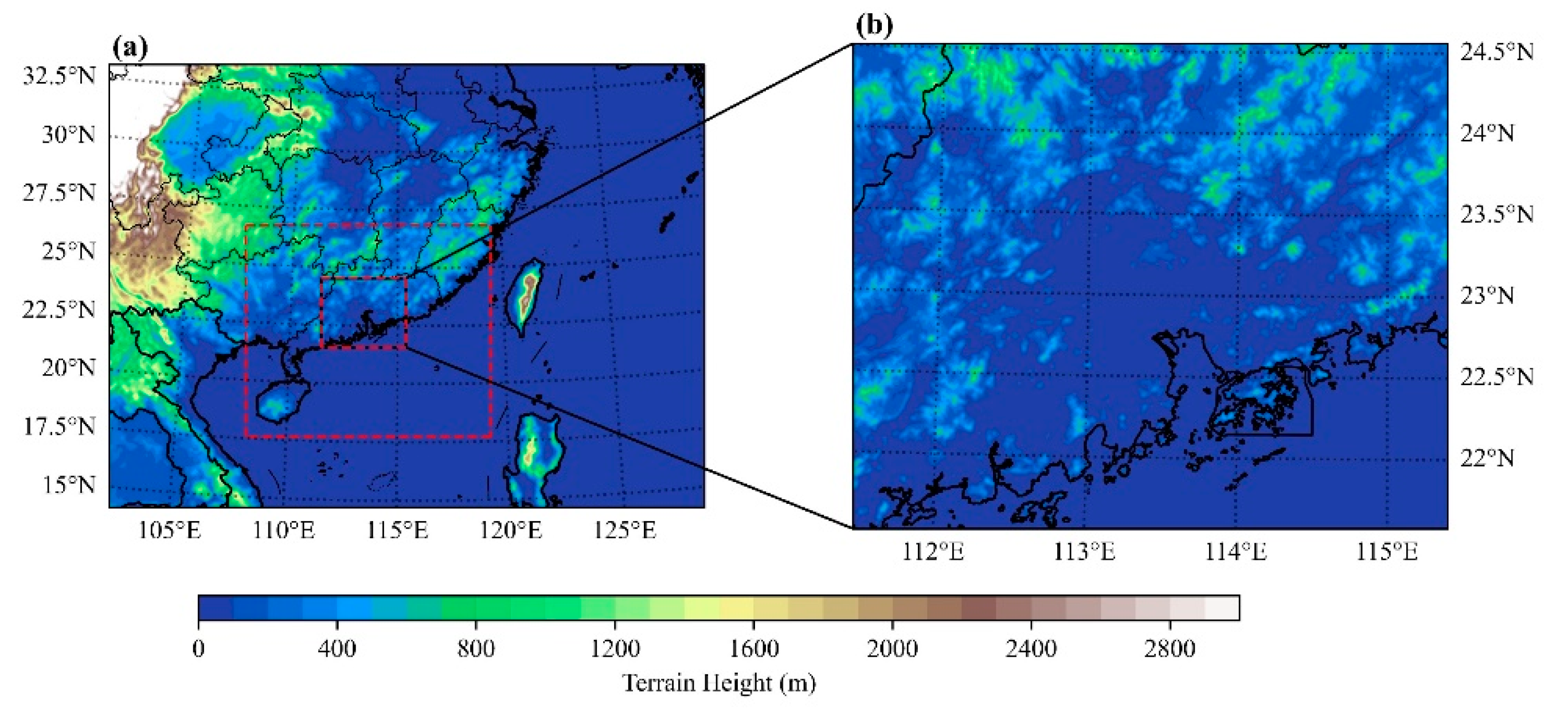
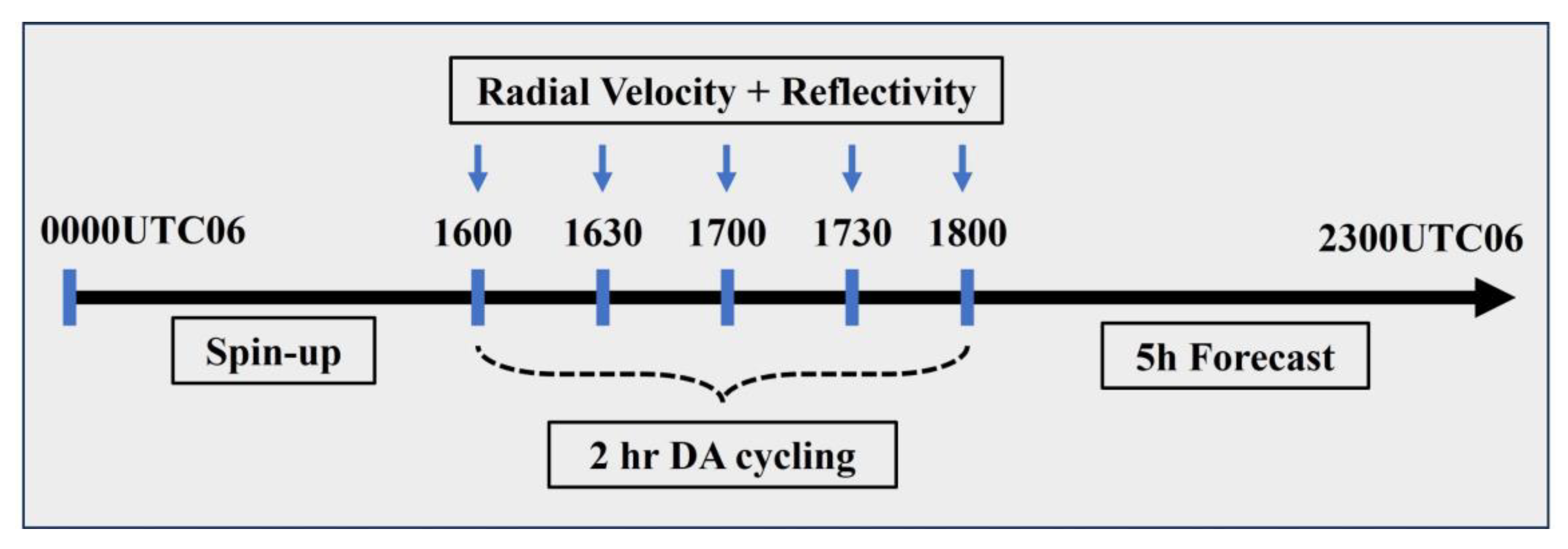
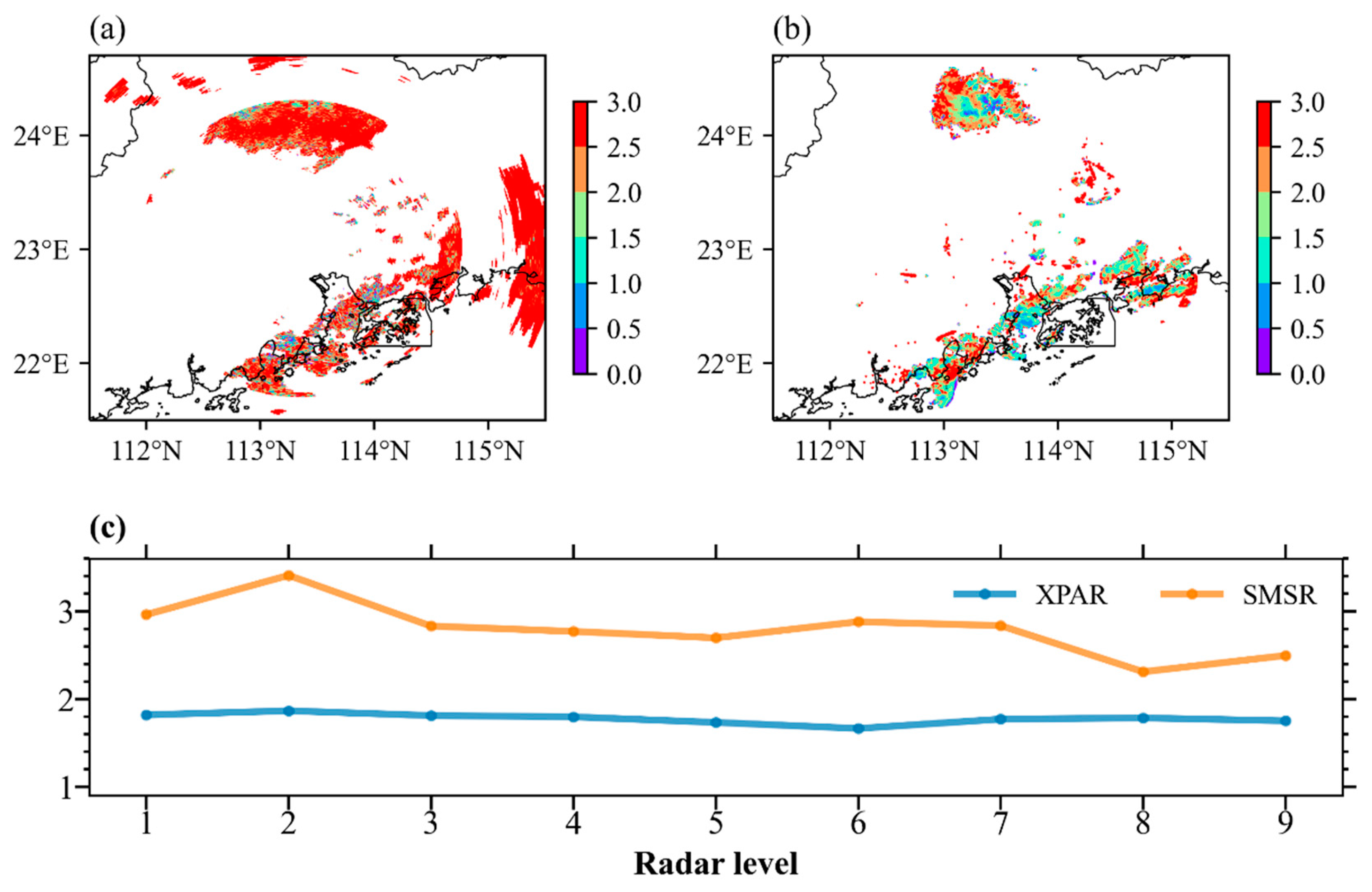




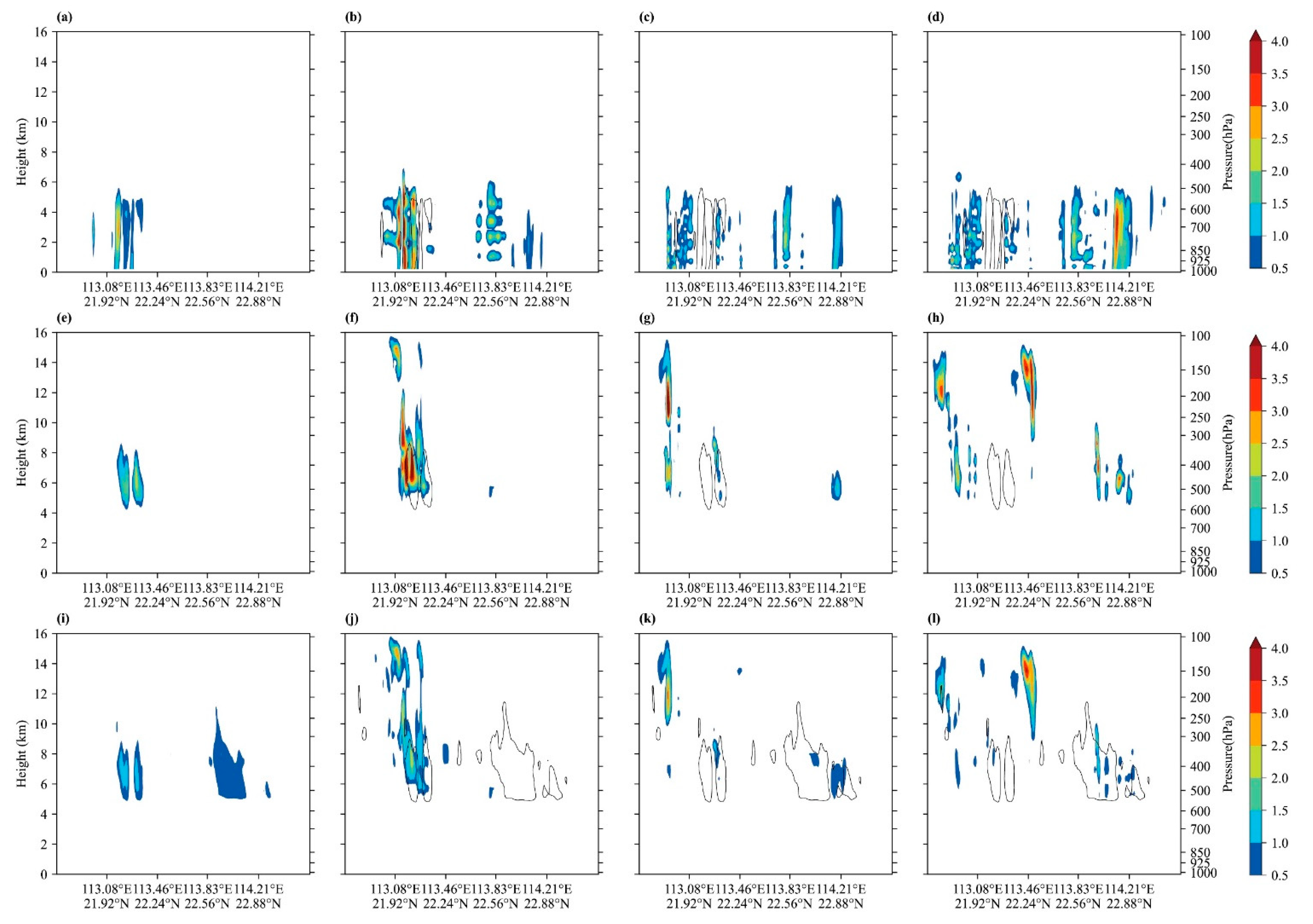
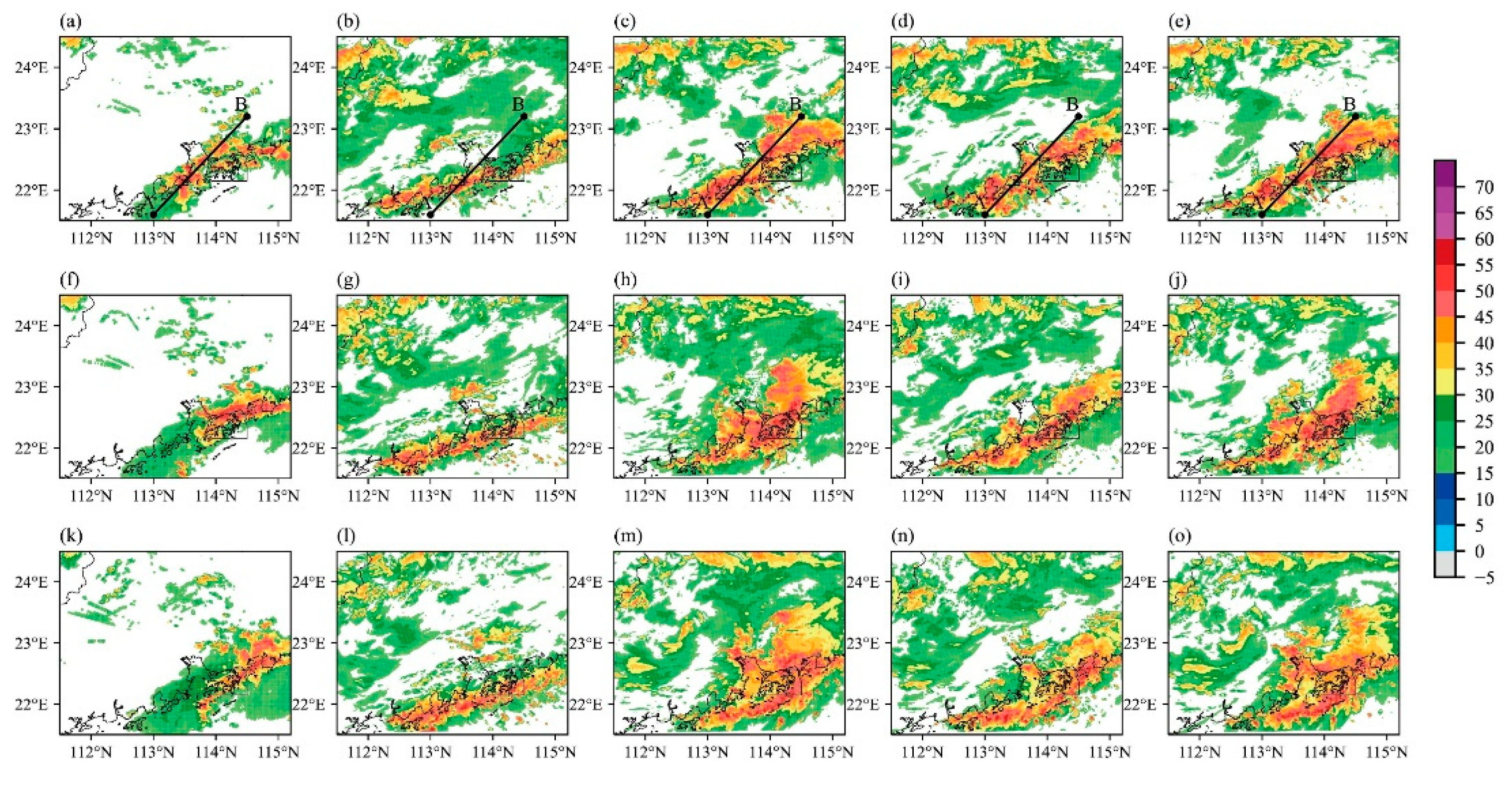
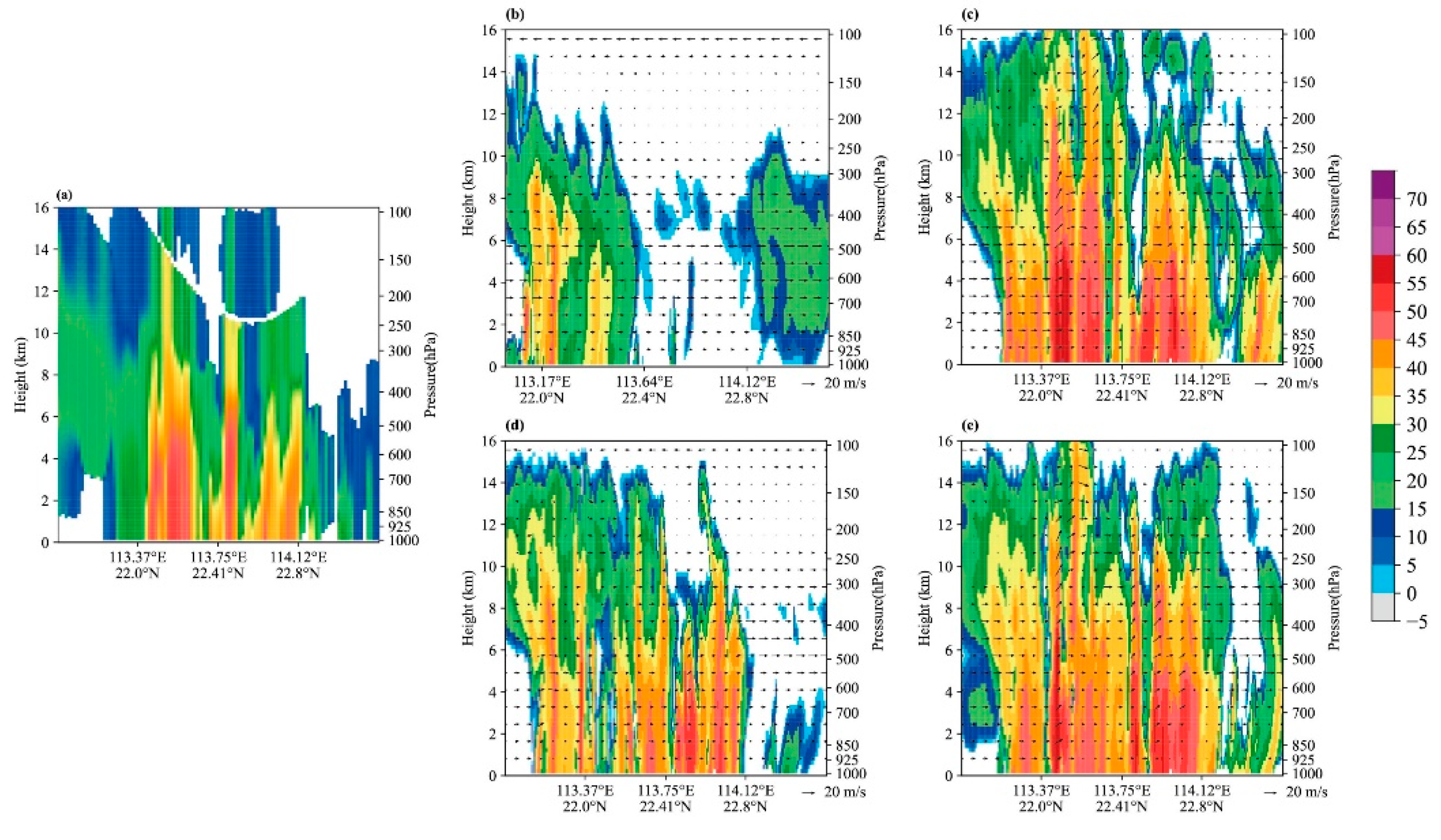

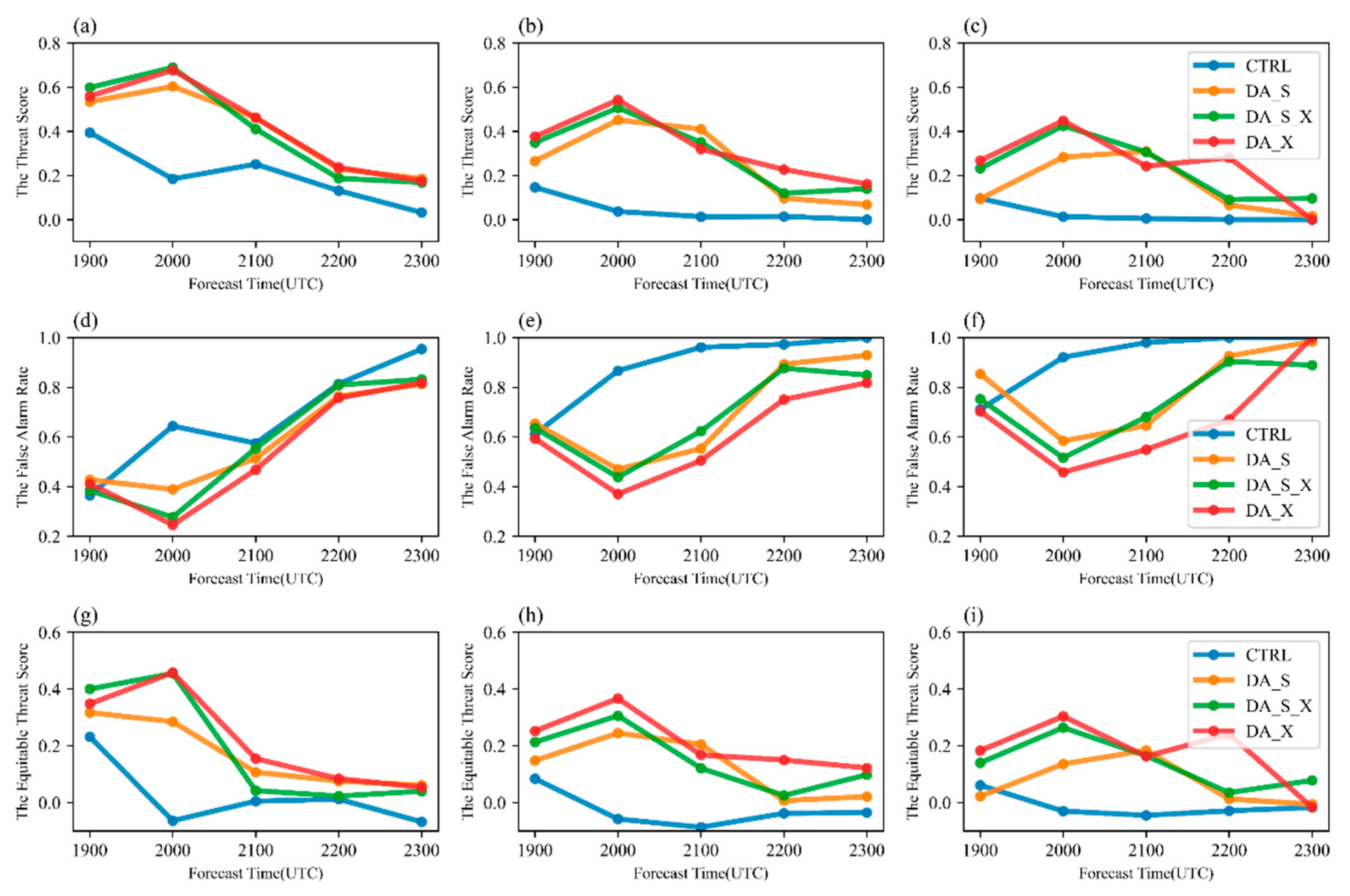
| Name | Scheme |
|---|---|
| CTRL | No DA |
| DA_S | Assimilating RV and RF of Guangzhou SMSR |
| DA_X | Assimilating RV and RF of nine XPARs |
| DA_S_X | Assimilating SMSR and XPARs data sequentially |
Disclaimer/Publisher’s Note: The statements, opinions and data contained in all publications are solely those of the individual author(s) and contributor(s) and not of MDPI and/or the editor(s). MDPI and/or the editor(s) disclaim responsibility for any injury to people or property resulting from any ideas, methods, instructions or products referred to in the content. |
© 2024 by the authors. Licensee MDPI, Basel, Switzerland. This article is an open access article distributed under the terms and conditions of the Creative Commons Attribution (CC BY) license (https://creativecommons.org/licenses/by/4.0/).
Share and Cite
He, L.; Min, J.; Yang, G.; Cao, Y. Contrasting the Effects of X-Band Phased Array Radar and S-Band Doppler Radar Data Assimilation on Rainstorm Forecasting in the Pearl River Delta. Remote Sens. 2024, 16, 2655. https://doi.org/10.3390/rs16142655
He L, Min J, Yang G, Cao Y. Contrasting the Effects of X-Band Phased Array Radar and S-Band Doppler Radar Data Assimilation on Rainstorm Forecasting in the Pearl River Delta. Remote Sensing. 2024; 16(14):2655. https://doi.org/10.3390/rs16142655
Chicago/Turabian StyleHe, Liangtao, Jinzhong Min, Gangjie Yang, and Yujie Cao. 2024. "Contrasting the Effects of X-Band Phased Array Radar and S-Band Doppler Radar Data Assimilation on Rainstorm Forecasting in the Pearl River Delta" Remote Sensing 16, no. 14: 2655. https://doi.org/10.3390/rs16142655





